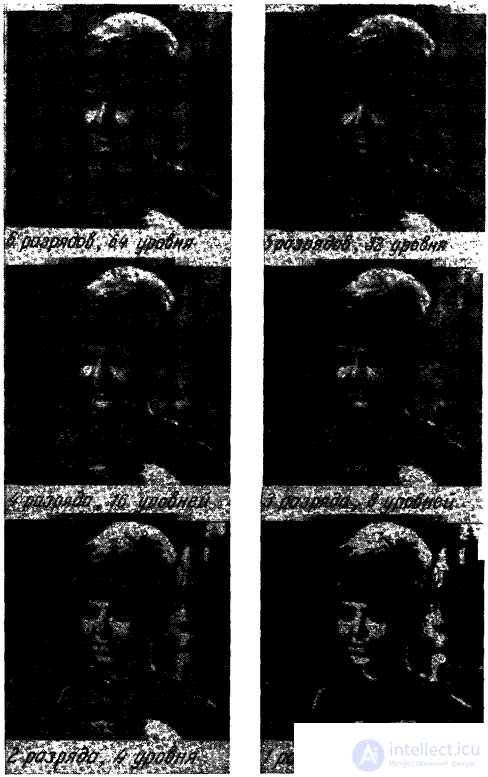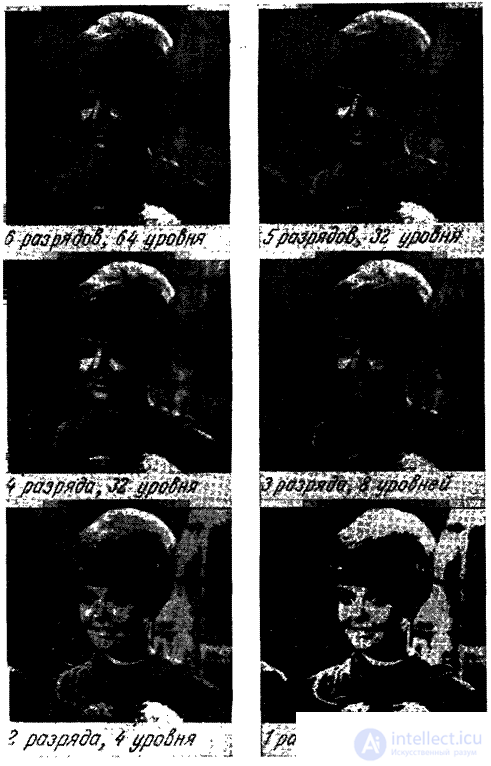Lecture
In single-color image transmission systems using pulse code modulation (PCM), each sample is quantized (usually based on a linear scale), and a binary code combination is assigned to it. As a rule, a uniform code is used, and therefore the number of lightness quantization levels is chosen from the condition
 , (6.4.1)
, (6.4.1)
Where  - the number of binary digits (bits) allocated for coding samples.
- the number of binary digits (bits) allocated for coding samples.
In systems with PCM, you can reduce the digital stream by simply reducing the number of digits in code combinations. If there is an analytical measure of the quality of images transmitted using such a system, then  will be equal to the smallest number of bits, in which the image quality is still satisfactory. When subjective quality assessment value
will be equal to the smallest number of bits, in which the image quality is still satisfactory. When subjective quality assessment value  reduced until the effects caused by quantization do not go beyond the permissible limits. The eye is able to determine from 10 to 15 gradations of the absolute value of lightness, but it has a much greater sensitivity to the difference in lightness of neighboring image elements. With a decrease in the number of quantization levels, the effect of the appearance of contours in those areas where the lightness of the original image changes smoothly is striking. The appearance of the contours is caused by a jump-like change in the lightness of the quantized image during the transition from one quantization level to another. The smallest number of PCM bits that prevent contours from appearing in areas with a smooth change in lightness depends on a number of factors, including the linearity of display characteristics and noise properties before and after converting an image to a video signal.
reduced until the effects caused by quantization do not go beyond the permissible limits. The eye is able to determine from 10 to 15 gradations of the absolute value of lightness, but it has a much greater sensitivity to the difference in lightness of neighboring image elements. With a decrease in the number of quantization levels, the effect of the appearance of contours in those areas where the lightness of the original image changes smoothly is striking. The appearance of the contours is caused by a jump-like change in the lightness of the quantized image during the transition from one quantization level to another. The smallest number of PCM bits that prevent contours from appearing in areas with a smooth change in lightness depends on a number of factors, including the linearity of display characteristics and noise properties before and after converting an image to a video signal.
Suppose that the samples at the output of the video signal sensor are proportional to the brightness of the image elements. There are questions: should the image luminance signal be directly quantized or should some function of it be and what should the quantizer characteristic be - linear or nonlinear? The last question is rather related to the practical implementation of the system. Any nonlinear characteristic of the quantizer can be obtained by performing a nonlinear transformation of the quantized signal, uniform quantization, and inverse nonlinear transformation of the quantized signal, as shown in the diagram in Fig. 6.1.3. In this regard, only uniform quantization of samples that can be previously subjected to nonlinear transformation will be considered here.
A large number of experimental works are known to determine the number (and location) of quantization levels necessary to minimize the effect of false contours [11-14]. Goodall [11] was one of the first to conduct experiments with digital television and came to the conclusion that in order to get good quality it is necessary to quantize the brightness image to 64 levels (6 bits), and at 32 levels (5 bits) false contours are not too noticeable. Similar results were obtained by other researchers. In the majority of papers, questions about the linearity of the characteristics of the image reproduction system and its calibration are addressed to some extent. The signals from a television camera and video monitor are usually non-linearly related to the intensity of light. Photographic materials used for recording images also have significantly non-linear characteristics. Finally, we note that any noises created by the camera or monitor conceal false contours.
In fig. 6.4.1 and 6.4.2 are photos, quantized with a different number of levels. In fig. 6.4.1 shows images obtained by uniform quantization of brightness with the number of levels from 2 to 64 (1 ÷ 6 binary digits). False contours are noticeable in the dark parts of the image when the number of digits does not exceed five. In fig. 6.4.2 shows the results of machine modeling of the process of uniform quantization of the optical density of the image. In this experiment, the values  - quantized to 256 levels (8 bits) samples of brightness, the values of which lie in the range from 0 to 1, were subjected to a logarithmic transformation:
- quantized to 256 levels (8 bits) samples of brightness, the values of which lie in the range from 0 to 1, were subjected to a logarithmic transformation:
.  .. (6.4.2)
.. (6.4.2)
Magnitude  was uniformly quantized to a different number of levels. Functions
was uniformly quantized to a different number of levels. Functions  describing the image with a quantized density, were then converted to functions
describing the image with a quantized density, were then converted to functions
 , (6.4.3)
, (6.4.3)
which describe images with quantized brightness. Comparison of fig. 6.4.1 and 6.4.2 shows that with uniform density quantization (Fig. 6.4.2), the effect of the appearance of false contours is not as pronounced as with uniform brightness quantization (Fig. 6.4.1).

Fig. 6.4.1. An example of uniform quantization of image brightness.

Fig. 6.4.2. An example of uniform quantization of image optical density.
In ch. 19 discusses digital image coding techniques for suppressing false contours that appear when there are not enough quantization levels.
Comments
To leave a comment
Digital image processing
Terms: Digital image processing